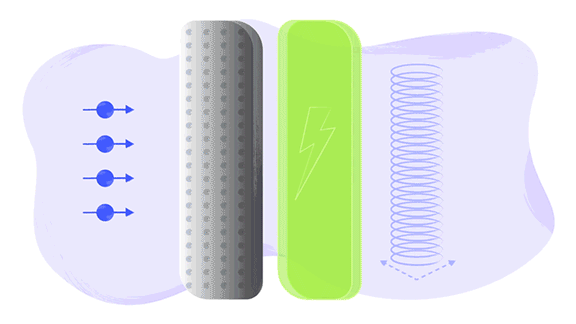NIST Scientists Reveal the Power Behind the Curtain — With Neutrons
Technique could permit detection of electric fields in hard-to-reach places, with potential security value.

In a potential step forward for imaging technology, scientists from the National Institute of Standards and Technology (NIST) and Sandia National Laboratories have developed a way to use neutrons to detect electric fields in spaces that are unreachable by conventional probes.
Their nondestructive but penetrative method, described in the journal Physical Review Letters, could lead to sensing devices that can see through walls to detect the electric fields in electronic components — a clearly useful capability for security screening and other diagnostic applications.
“This is the first time anyone has been able to image an electric field that has been physically isolated,” said Dan Hussey, a NIST physicist. “There could be something that you don’t want to disassemble but want to inspect. This approach might offer a way to see its electric fields even though barriers stand in the way.”
The technique requires an intense beam of polarized neutrons, the particles that together with protons form the nuclei of all elements other than simple hydrogen. Neutrons possess the ability to penetrate dense materials, such as metals, which block the passage of other particles or types of radiation.
Unlike charged particles, such as positively charged protons, neutrons possess no net electric charge. However, they do have a magnetic property called spin, which can be manipulated by a magnetic field. The neutron’s spin direction is affected by magnetism — something the research team used to their advantage.
“The neutron is electrically neutral, and yet we’re using it to sense the electric field,” Hussey said.
The idea originated with Sandia physicist Yuan-Yu Jau, who recently began a Laboratory Directed Research and Development (LDRD) project to detect electric fields in spaces unreachable by conventional probes. To realize it, Jau needed a good source of neutrons and capable detectors — needs that led him to the NIST Center for Neutron Research (NCNR).
When a neutron passes through the electric field, it is equivalent to the electric field moving toward a stationary neutron; only the perspective, or frame of reference, is different. And when the source of an electric field moves, it generates a magnetic field.
Even for the strong electric field employed in this demonstration experiment, the effective magnetic field was weak (about 50 times smaller than Earth’s magnetic field). Nevertheless, this weak magnetic field tilted the direction of the neutron’s magnetic spin slightly. In the experiments, the tilt angle was less than a degree, but using a sensitive polarimetry method developed by the team, a small rotation was measured with an accuracy of about one hundredth of a degree.
To make this accurate measurement, Hussey and his NIST colleagues built on the NCNR’s established capabilities in polarimetry to develop a method that is about 100 times more sensitive than conventional polarimetry. Their method depends on the behavior of the neutrons’ spins as they pass into a type of electromagnet called a solenoid, used in conjunction with a polarized neutron spin filter. This device was developed for other purposes, but it proved ideal for this research.
The conditions of the experiment might seem to undercut the practical value of the technique for use in the field, as the team required an inconveniently large reactor to generate the neutron beam. However, smaller, commercially available neutron generators do exist, suggesting that the method might one day be harnessed by portable equipment if it could generate a strong enough beam of neutrons.
Hussey emphasized that the results demonstrate only that the concept is valid. “We didn’t leap ahead to trying to see inside metal objects, but that’s coming in the near future,” he said.
However, the sensing technique could find more uses as researchers design experiments around it.
“You might want to diagnose high-voltage electronics while they’re operating, or potentially study materials that have electric properties in sample environments,” Hussey said. “Now that the capability exists, perhaps other ideas will emerge.”
Y-Y. Jau, D.S. Hussey, T.R. Gentile and W. Chen. Electric field imaging using polarized neutrons. Physical Review Letters. Sept. 10, 2020. DOI: 10.1103/PhysRevLett.125.110801

